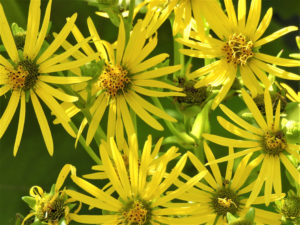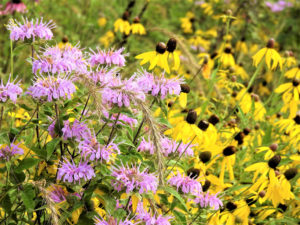Late summer prairies provide the best wildflower show around
By Charlie Frisk
Correspondent
The best wildflower show from August through early October is on the prairies and savannas.
Woodland flowers have to bloom early in the spring before the trees are fully leafed out, but prairies plants can take full advantage of long, warm days and bloom later in the summer.
Most people think of Northeast Wisconsin as all forested in the pre-European settlement days, but many areas were either prairie or oak savanna.
Prairies and oak savannas are both fire-dependent ecosystems.

On prairies, fire prevents woody vegetation from intruding, and on savannas, fire stops woody undergrowth from developing but doesn’t kill the mature, thick barked larger oaks.
Ecologists are still debating how much of those areas were strictly natural versus deliberately managed with fire by Native Americans.
Without a doubt, controlled burns carried out by natives increased the acreage of prairies and savannas in the Midwest.
Native people conducted burns for a variety of reasons.
Wisconsin tribes were farmers along with hunting and gathering.
Opening up areas by burning made for more efficient production of corn, beans and squash.
Reducing the amount of undergrowth also helped control populations of biting insects.
Elk and bison both preferred prairie and savanna over forests because they both graze on grasses – bison almost entirely and elk for a portion of their diet.
Bison and elk were much larger than white-tail deer, and bison meat was easier to preserve by drying than venison due to its lower fat content.
Both elk and bison skins were better for making clothing, tools and shelters than the hides from deer.
Oak savanna stretched along the east shore of Green Bay from the city of Green Bay all the way to Door County.
Much of the west shore of Green Bay was mixed prairie and wetlands.

In fact the last prairie chicken flocks in eastern Wisconsin were sighted along the west shore of Green Bay in the late 1960s.
Prairie and savanna soils are very fertile and most of those lands have been converted to agriculture.
It is estimated that less than 1% of Wisconsin’s original prairies still exist, and less than one-tenth of 1% of the savannas still remain.
This has threatened the continued existence of many prairie and savanna plants and also the birds, mammals, reptiles, amphibians and insects that depend on those environments.
Both government conservation agencies and non-profit environmental groups are working to preserve the native prairies and savannas that still exist.
There is also a movement to restore marginal farmlands back to prairies and savanna.
Restored prairies will never have the plant diversity of native prairies.
A native tall-grass prairie can have 200-400 species; a really excellent restored prairie might have 50 species.
However, restored prairies can be quite beautiful and provide habitat for many of the animal species found on native prairies.
Prairies and savannas restore soil fertility, reduce runoff and assist in the battle against climate change by pulling significant amounts of carbon out of the atmosphere and storing it for decades, even centuries, in the soil.
Both the bird and insect show on prairies and savannas can be quite spectacular. Butterflies, particularly monarchs and swallowtails, are very common, as well as many types of dragonflies and bumblebees.
Meadowlarks, bobolinks, dickcissels, sandhill cranes and many other bird species are found on Wisconsin prairies.
Red-headed woodpeckers are highly dependent on oak savannas, and both were once very common in the Midwest.
Anyone over 60 can remember when red-headed woodpeckers were one of our most common woodpeckers, but their numbers have declined dramatically along with the acreage of oak savanna.
The prairie flower show changes as the seasons move along.
The more often you get out on the prairies the more species you will see.
For at least another month, the prairie flower show will be quite exciting.
Make a point to get out and see it!
Some excellent places to view prairie plants and animals are:
The Arboretum on the UWGB campus
Barkhausen Waterfowl Preserve
To get to Barkhausen, take I-41 North to Lineville Road (East, right), then Lakeview Drive (North, left).
Baird Creek Greenway
• Take the trail going north out of Christa McAuliffe Park to a small prairie opening.
• The large open field on McKenzie Lane.
• The Hartman Prairie. Located on Hwy. JJ just across from a farmhouse at 4677 Co Rd JJ. The Hartman Prairie is a great place to see bobolinks, meadowlarks, sand hill cranes and monarch butterflies.
• Just east of the Triangle Hill tubing hill is a restored oak savanna. Red-headed woodpeckers have been sighted there and hopefully will develop a breeding population.
